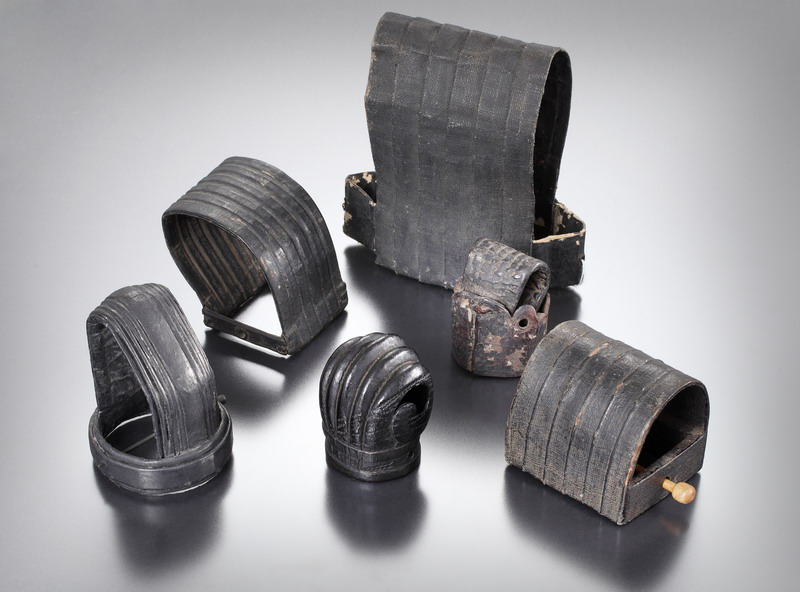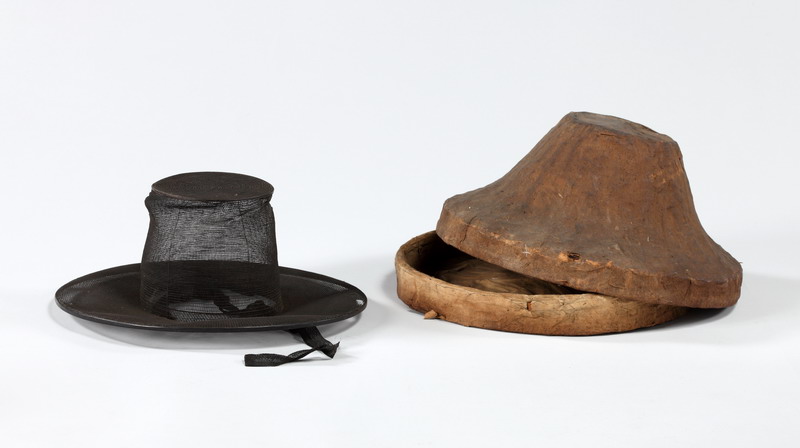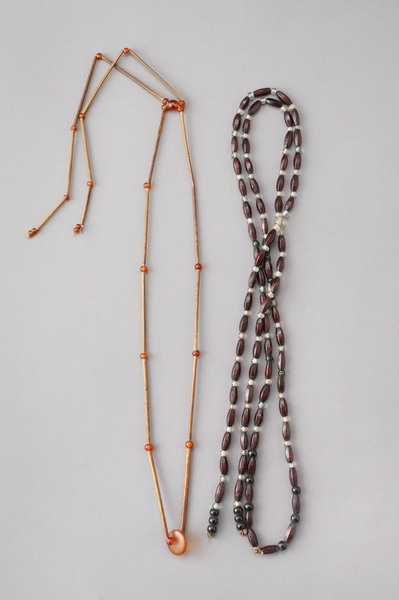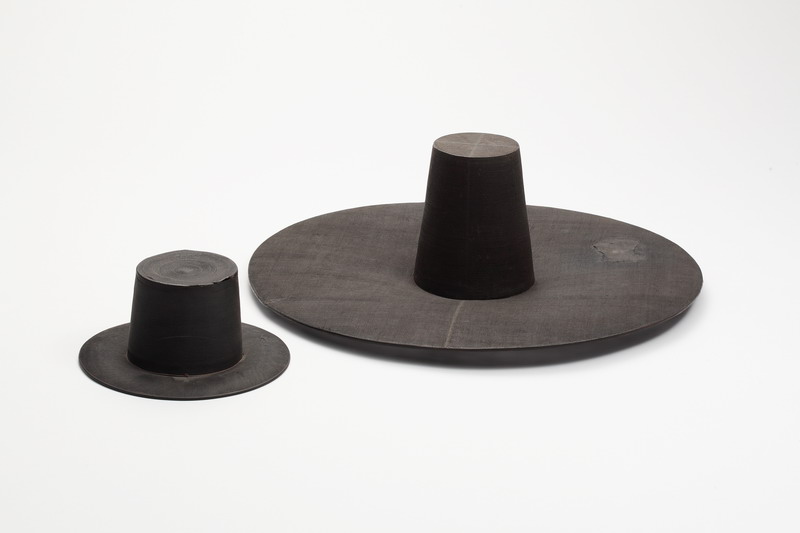The Land of Hats
By Diane Dooley
When the drama Kingdom first aired on Netflix in 2019, international viewers were fascinated by the “fancy hats” worn by its male characters: Joseon scholars, royalty, and soldiers. These wide-brimmed hats, embellished with feathers and beaded strings, as well as the actors who wore them, attracted domestic and international media interest for several weeks.
Why hats? Today, hats are primarily seen as a fashion accessory, but hair has always held a great deal of symbolic significance in societies. Joseon Korea (1392–1897) was no exception: Hairstyles and the various accessories used to maintain and decorate them during the Joseon Dynasty were imbued with sociocultural meaning. Men’s headwear, in particular, became an emblem of the Joseon Dynasty to the extent that foreign missionaries frequently referred to Korea as “The Land of Hats” in their writings.
Hair and Neo-Confucianism
Joseon society was, of course, dominated by neo-Confucian ideology. Hats and hairstyles played a significant role in maintaining Joseon’s strict hierarchical structure. While it is difficult to define neo-Confucianism because it meant different things to different intellectuals, kings, and individuals at different points throughout the Joseon Dynasty’s long history, the nature of neo-Confucianism as practiced during the Joseon Dynasty can be broadly characterized by the maintenance of a strict social hierarchy in which relationships were inherently unequal. These relationships were maintained through various, highly ritualized behaviors and ceremonies. And what behavior is more ritualized than personal grooming?
Various hairstyles and headgear were imported to Joseon Korea from Ming China, but with the demise of Ming in 1644 and the rise of neo-Confucianism in Korea, various changes occurred to styles of dress. This was a gradual process: Customs and traditions from the preceding Goryeo Dynasty did not disappear overnight, nor did people always accept new government regulations on dress enthusiastically. Much like today, personal preferences sometimes won the battle against ideologically or socially accepted modes of dress.
The relationship between parent and child – an important relationship to neo-Confucian ideologues – is particularly significant in assessing the significance of Joseon hairstyles. Confucianism proscribed the cutting of hair as it was said that the entirety of a man’s body – including the hair on his head – belonged to his parents. Hairstyles during the Joseon Dynasty were therefore based on uncut hair; long hair, maintained correctly, functioned as a conspicuous marker of filial piety. Therefore, all males typically tied their long hair up in high, tight topknots (sangtu, 상투), which James Scarth Gale described in his writings on Korea as being tied “tight enough to squeeze tears from the eyes.” As Gale’s description vividly highlights, these hairdos were severe, almost restrictive – a reflection of Joseon’s rigid social order.

Age was an important marker of relative status in Joseon, as it is in contemporary Korean society, and the topknot represented male adulthood. The capping (gwallye, 관례) of the groom was a preliminary wedding rite in which hair played a prominent role. It was known as the “adding of the three things” (samga, 삼가): First, the groom’s washed hair was tied up in a topknot in front of family members and guests. After that, a hat known as the gat (갓) was adorned, and this was secured by a third item, a practical headband (manggeon, 망건). This ceremony initiated the groom into adulthood prior to his nuptials.

The Gat
The wide-brimmed gat is the representative hat of Joseon Korea. This hat became an extension of men’s bodies during the Joseon Dynasty. Not only did these hats indicate social status, age, rank, and function as a conspicuous marker of filial piety, but they also represented the neo-Confucian idea of decorum: Maintaining one’s hair in the correct way was considered a key aspect of proper gentlemanly behavior. “Gat” is a general term used for any hat with a brim; several different styles of gat were made. The heungnip (흑립), as the representative hat for officials over the centuries, was the frontrunner in men’s headwear during the Joseon Dynasty. This hat was worn exclusively by yangban (양반) men who had passed the civil service examinations. Yangban men would not dare be seen outside without wearing one of these dapper hats – a tangible representation of their social status.
Headwear and Propriety
Many changes to the gat occurred throughout the Joseon Dynasty: in shape, size, brim width, as well as the materials used to construct and decorate them, fluctuating with the economic and fashion trends of the day. For example, philosopher Yi Mun-deok considered wider-brimmed gat to reflect an “indolent and arrogant disposition.” Styles also differed according to rank – only members of the royal family were allowed to use gold and only officials from the first to third rank were permitted to use silver for the embroidery of their hats.
It is clear that hat and hair etiquette were taken seriously by Joseon gentlemen. In fact, yangban men considered showing their bare topknot hairstyle to be “indecent” – even in the privacy of their own homes. Unless they were sleeping, their topknots remained covered at all times. For this reason, various types of comfortable headwear intended for use in the home were introduced. Joseon-style loungewear, in a sense. Various types of geon (건) and gwan (관) were used for this purpose. Men also wore headbands, typically made from horsehair underneath their gat. This headband was worn around the head and tied at the back: Its purpose was to prevent disheveling of the topknot and to secure other headgear in place. Upper-class men were rarely seen with loose hair. Paintings and written accounts of corporal punishment from the Joseon Dynasty depict images of disheveled topknots, which suggests a link between loose hair and loose morals: Only those from the lowest social strata or criminals would be seen with even a single hair out of place.

Topknot Riots
As a result, over time, the topknot hairstyle itself became as much a part of Joseon male masculine identity as the Confucian principles of which it was symbolic. Towards the end of the Joseon Dynasty, during the Kabo Reforms (1894–1896), the topknot became the subject of much debate and even led to riots. The Kabo Reforms were a set of Japanese-backed reforms introduced during the reign of King Gojong primarily as a response to growing civilian unrest, specifically the Donghak Peasant Rebellion, a series of civilian struggles against oppressive tax and labor laws. These civilian struggles originated here in Jeolla-do, near Jeong-eup, and spread throughout the country. One of the reforms, introduced in 1895, was an edict stating that all adult men must cut off their topknots (danbal-lyeong, 단발령, or “Short Hair Edict”) for reasons of “hygiene and efficient transaction of business.” This edict caused social and even economic turbulence for several months. James Scarth Gale made note of one man who committed suicide to avoid cutting his hair: “As a lad, this young prince had been taught to count every hair on his head … a link that bound him to his father and mother.” This was a common sentiment: Prominent Confucian scholar and politician Choi Ik-hyeon stated, “I would rather have my head cut off than my hair.” The resulting chaos even caused inflation: Farmers were afraid to enter the capital because they thought they would have their hair cut off. In fact, the fear of having one’s topknot cut off even featured in folklore: Mischievous creatures known as dokgebi (독개비) were said to cut off men’s topknots while they were walking in the street “unawares” – and thus one must ensure that one’s hair is tightly bound at all times!
Beyond Fashion
The tightly bound topknots preferred by Joseon men, secured in place and covered by various hats and accessories, reflect various neo-Confucian principles: filial piety, decorum, propriety, adherence to a strict social hierarchy, and knowing one’s place in society. However, hats and hairstyles meant more to Joseon men than a mere physical representation of Confucian principles. They also came to symbolize Joseon as a nation. These hats became the representative image of Joseon abroad as a tangible manifestation of Joseon male masculine identity as well as national identity – especially when Joseon began to gradually lose its sovereignty to its more powerful neighbors.
Photographs courtesy of National Folk Museum of Korea.
Sources
Ch’oe, U., et al. (2012). Gat: Traditional headgear in Korea. Kungnip Munhwajae Yŏn’guso.
Chung Y. (1998). The art of the Korean potter. In J. Smith (Ed.), Arts of Korea. The Metropolitan Museum of Art.
Cumings, B. (1997). Korea’s place in the sun. W. W. Norton.
Deuchler, M. (1992). The Confucian transformation of Korea. Council on East Asian Studies, Harvard University.
Gale, J. S. (1909). Korea in transition. Young People’s Missionary Movement of the United States and Canada.
Nelson, S. M. (1998). Bound hair and Confucianism in Korea. In A. Hiltebeitel & B. D. Miller (Eds.), Hair: Its power and meaning in Asian cultures. State University of New York Press.
Paik, H. I. (2000). Constructing “Korean” origins. Harvard University Asia Centre.
Park, H. (2010). (Ad)Dressing Joseon portraiture: The British Museum’s portrait of Chae Je-Gong. Orientations, 41(8).
The Author
Diane Dooley is originally from Glasgow, Scotland, and has a BA in Korean and an MA in Korean literature. She enjoys reading, coffee, and talking about Korea to anyone willing to listen. She currently lives and works in Gwangju as an English teacher and is passionate about education. E-mail: dianedooley@naver.com







